What To Clean Walls And Baseboards With
Introduction
What To Clean Walls And Baseboards With: When it comes to cleaning walls, the first step is to determine the type of paint or wallpaper you have. This is important because certain cleaning agents can damage or discolor certain types of paint or wallpaper. For example, walls with a flat or matte finish are more delicate and should be cleaned with gentle, non-abrasive cleaners. On the other hand, walls with a semi-gloss or high-gloss finish can withstand more rigorous cleaning methods.
For most painted walls, a mild detergent mixed with warm water is usually sufficient to remove dirt and stains. Simply dip a sponge or cloth into the soapy water and gently scrub the walls in a circular motion. Be sure to wring out excess water from the sponge or cloth to avoid saturating the walls. After cleaning, rinse the walls with clean water and dry them thoroughly with a soft, lint-free cloth.
When it comes to baseboards, they often collect dust and dirt more easily than walls. To clean baseboards heat, start by using a dry cloth or duster to remove loose dirt and dust. Gently scrub the baseboards, paying extra attention to any stubborn stains or marks. Rinse the baseboards with clean water and dry them thoroughly to prevent any water damage.

What is the best thing to clean walls with?
Mild detergent and water: This can be done by mixing a few drops of dish soap or a mild household cleaner with warm water. Use a soft sponge or cloth to gently scrub the walls, working from top to bottom. Rinse the walls with clean water and dry them with a soft towel.
Vinegar: Vinegar is a natural and versatile cleaning agent that can be used to clean walls. Mix equal parts of vinegar and water in a spray bottle and spray the solution onto the walls. Let it sit for a few minutes, then use a sponge or cloth to wipe away the dirt and stains. Vinegar is particularly effective for removing grease and grime.
Baking soda: Baking soda is another natural cleaning agent that can be used to clean walls. Make a paste by mixing baking soda with water, and apply it to the stained areas of the walls. Gently scrub the walls with a sponge or cloth, then rinse with clean water. Baking soda is especially useful for removing tough stains and odors.
Commercial wall cleaners: There are also a variety of commercial wall cleaners available in the market. These cleaners are specifically formulated to clean walls without causing any damage. It is important to read and follow the instructions on the product label to ensure safe and effective use. Test the cleaner on a small, inconspicuous area of the wall before applying it to the entire surface.
Professional cleaning services: Professional cleaners have the knowledge, experience, and equipment to safely and effectively clean walls without causing any damage.
What do you clean walls and baseboards before painting?
However, in general, warm, soapy water is typically the best approach. You’ll eliminate most of the dust and grime, resulting in a surface that’s much smoother for applying paint.
Before painting walls and baseboards, it is important to properly clean them to ensure a smooth and long-lasting finish. There are several steps and techniques that can be followed to effectively clean walls and baseboards before painting.
The first step in cleaning walls and baseboards is to remove any loose dirt or dust. It is important to pay attention to corners, edges, and hard-to-reach areas where dust tends to accumulate. Next, any stains or marks on the walls and baseboards should be treated. This can be done by using a mild detergent or cleaner and a soft cloth or sponge. After treating the stains, the surfaces should be rinsed with clean water and dried thoroughly.
In addition to removing dirt and stains, it is also important to remove any grease or oily residue. Grease can be particularly problematic as it can prevent the paint from adhering properly. To remove grease, a degreaser or a mixture of warm water and mild dish soap can be used. Afterward, the surfaces should be rinsed with clean water and dried thoroughly.
Finally, after cleaning the walls and baseboards, it is important to ensure that they are completely dry before painting. Once the surfaces are dry, they are ready to be primed and painted.
How do you clean painted walls and trim?
Use warm water and an all-purpose cleaner for walls with latex paint. This will prevent the dirt from spreading and scratching the paint surface during the cleaning process. It’s important to be gentle and avoid using abrasive materials that could damage the paint.
Next, prepare a cleaning solution by mixing a mild detergent or dish soap with warm water. Avoid using harsh chemicals or abrasive cleaners, as they can strip the paint or cause discoloration. Gently scrub the walls and trim in a circular motion, starting from the top and working your way down. Be sure to pay extra attention to any areas with stains or marks, using a bit more pressure if necessary.
After scrubbing, rinse the sponge or cloth with clean water and go over the walls and trim again to remove any soap residue. It’s important to thoroughly rinse the surfaces to prevent any residue from drying and leaving streaks or marks. Use a clean, dry cloth to wipe away any excess moisture and allow the walls and trim to air dry completely.
What do professional painters use to clean walls before painting?
Professional painters use a variety of tools and techniques to ensure that walls are properly cleaned before painting. One common tool that professional painters use to clean walls is a TSP cleaner, which stands for trisodium phosphate. TSP is a powerful cleaner that helps to remove grease, grime, and other stains from walls. It is mixed with water and applied to the walls using a sponge or brush. After scrubbing the walls, the TSP solution is rinsed off with clean water to remove any residue.
In addition to TSP, professional painters may also use a degreaser or a mild detergent to clean walls. This helps to create a smooth surface for the paint to adhere to and ensures a professional finish. Sanding should be done carefully and evenly to avoid damaging the walls.
Professional painters use a combination of tools and techniques to clean walls before painting. This includes using TSP or other cleaning products to remove dirt, grease, and stains, as well as sanding to smooth out any imperfections. By properly cleaning the walls, professional painters can ensure that the paint adheres properly and provides a professional finish.”
What do painters use to clean walls before painting?
Painters use a variety of methods and tools to clean walls before painting. This is effective for removing light dust and dirt, as well as any loose paint or debris. However, for more stubborn stains or heavily soiled walls, painters may need to use a stronger cleaning solution.
Another option for cleaning walls is to use a mild detergent or cleaning solution. This can be mixed with water and applied to the walls using a sponge or brush. The solution is then rinsed off with clean water to remove any residue. This method is particularly useful for removing grease or oil stains, as well as any built-up grime.
In some cases, painters may need to use a more aggressive cleaning method, such as sanding or scraping. Overall, painters have a range of options for cleaning walls before painting. The method they choose will depend on the specific needs of the project and the condition of the walls. One popular option is a mixture of warm water and mild dish soap. This gentle solution is suitable for most types of walls and baseboards and can effectively remove dirt, grime, and fingerprints.
Another effective cleaning solution is a mixture of white vinegar and water. Vinegar is known for its natural cleaning properties and can effectively cut through grease and stubborn stains. Simply mix equal parts of vinegar and water in a spray bottle and apply it to the walls and baseboards. Let it sit for a few minutes before wiping it off with a clean cloth or sponge.
Are there any specific cleaning products or tools recommended for cleaning walls and baseboards?
When it comes to cleaning walls and baseboards, using the right cleaning products and tools can make a significant difference in achieving effective results. One of the most commonly recommended cleaning solutions for walls and baseboards is a mixture of warm water and mild dish soap. This gentle solution helps to remove dirt, grime, and stains without causing any damage to the surfaces.
In addition to the warm water and dish soap mixture, there are also specific cleaning products available in the market that are designed specifically for walls and baseboards. These products often contain ingredients that help to break down tough stains and grease, making the cleaning process easier and more efficient. It is important to read the instructions and follow the recommended usage guidelines when using these specialized cleaning products.
How often should walls and baseboards be cleaned?
When it comes to cleaning walls and baseboards, the frequency will depend on various factors such as the amount of traffic in the area, the type of finish on the walls, and the level of dirt and grime buildup. Generally, it is recommended to clean walls and baseboards at least once every 6 months to maintain their appearance and prevent the accumulation of dust and dirt.
However, certain areas may require more frequent cleaning. For example, high-traffic areas like hallways or kitchens may need to be cleaned more often, perhaps every 3 months, to keep them looking fresh and clean. Additionally, if you have pets or young children who are prone to touching or rubbing against walls, you may need to clean more frequently to remove any smudges or stains.
When cleaning walls and baseboards, it is important to use gentle cleaning solutions and tools to avoid damaging the surfaces. Avoid using abrasive cleaners or scrub brushes that can scratch or remove the paint or finish. Instead, opt for mild soapy water or a mixture of vinegar and water for a natural cleaning solution. Use a soft cloth or sponge to gently wipe down the walls and baseboards, paying attention to any areas with visible dirt or stains.
Are there any special techniques or tips for effectively cleaning walls and baseboards?
When it comes to effectively cleaning walls and baseboards, there are a few special techniques and tips that can make the task easier and more efficient. Firstly, it is important to start by removing any dust or loose dirt from the surfaces. This can be done by using a soft-bristle brush or a vacuum cleaner with a brush attachment. By removing the loose debris first, you can prevent it from spreading and smearing during the cleaning process.
Next, it is recommended to use a mild cleaning solution or a mixture of warm water and a gentle detergent. Avoid using harsh chemicals or abrasive cleaners, as they can damage the paint or finish on the walls and baseboards. Dip a sponge or a microfiber cloth into the cleaning solution and gently wipe the surfaces, starting from the top and working your way down. Be sure to wring out the sponge or cloth well to avoid excessive moisture on the walls.
Are there any precautions or considerations to keep in mind when cleaning walls and baseboards?
When cleaning walls and baseboards, it is important to take certain precautions and considerations to ensure that you do not damage the surfaces or cause any harm to yourself. Firstly, always test any cleaning solution or product on a small, inconspicuous area of the wall or baseboard before applying it to the entire surface. This will help you determine if the solution is safe to use and will not cause any discoloration or damage.
Additionally, be mindful of the type of paint or finish on your walls and baseboards. Different types of paint may require different cleaning methods or products. For example, if you have walls with a matte finish, it is best to avoid using abrasive cleaners or scrub brushes, as they can leave behind scratches or marks. Instead, opt for a gentle cleaner and a soft cloth or sponge.
It is important to protect yourself while cleaning. Wear gloves to protect your hands from any harsh chemicals in the cleaning solutions, and consider wearing goggles if you are using any sprays or aerosols. It is also a good idea to open windows or use fans to ensure proper ventilation while cleaning.

Conclusion
When it comes to cleaning walls and baseboards, it is important to use the right tools and products to ensure a thorough and effective cleaning. Using a combination of mild detergent, warm water, and a soft cloth or sponge is a great way to remove dirt, dust, and grime from walls. Additionally, using a microfiber cloth or a soft-bristle brush can help to gently scrub away any stubborn stains or marks.
For baseboards, it is important to first remove any loose dirt or dust using a vacuum cleaner or a dry cloth. Once the surface is free from loose debris, a mixture of warm water and mild detergent can be used to wipe down the baseboards. It is important to avoid using harsh chemicals or abrasive cleaners, as they can damage the paint or finish on the baseboards.
Regular maintenance and cleaning of walls and baseboards can help to keep them looking fresh and clean. It is recommended to clean walls and baseboards at least once every few months, or more frequently if they are in high-traffic areas or prone to getting dirty easily. By following these cleaning tips and using the right tools and products, you can ensure that your walls and baseboards stay in great condition for years to come.








